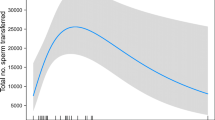Abstract
Laboratory experiments were conducted to clarify the relationship between female sexual receptivity and male copula guarding inI. senegalensis, a species that copulates for several hours. In insectaries, most copulations were initiated early in the morning, and terminated relatively synchronously between 11 00 and 13 00. Females refused males with wing-flutter display and oviposited alone in the afternoon regardless of copulation events of that morning. Females could sexually receive males only in the morning. Males copulated for several hours until 12 00 after which females could oviposit. To determine whether copulations that last for hours function as male copula guarding or only of sperm displacement, emerged males were kept at various densities and permitted to copulate with virgin and mated females in insectaries. Both with virgin and mated females, “social” (not solitary; 2–4 males / insectary) males initiated copulations early in the morning and always terminated at around 12 00. However, both with virgin and mated females, solitary (one male / insectary) males terminated copulations in the morning. In both cases, duration of copulations did not significantly differ for virgin females and mated females. Therefore, long (several hour) copulation is more likely to function as male copula guarding than as sperm displacement, and duration of copulations is predicted to be shortened when male density is very low.
Similar content being viewed by others
References
Alcock, J. 1994 Postinsemination associations between males and females in insects: the mateguarding hypothesis.Annual Reviews of Entomology, 39, 1–21.
Carroll, S. P. 1991 The adaptive significance of mate guarding in the soapberry bug,Jadera haematoloma (Hemiptera: Rhopalidae).Journal of Insect Behavior, 4, 509–530.
Carroll, S. P. & J. E. Loye 1990 Male-biased sex ratios, female promiscuity, and copulatory mate guarding in an aggregating tropical bug,Dysdercus bimaculatus.Journal of Insect Behavior, 3, 33–48.
Cordero, A. 1989 Reproductive behaviour ofIschnura graellsii (Rambur) (Zygoptera: Coenagrionidae).Odonatologica, 18, 237–244.
Cordero, A. 1990 The adaptive significance of the prolonged copulations of the damselfly,Ischnura graellsii (Odonata: Coenagrionidae).Animal Behaviour, 40, 43–48.
Fincke, O. M. 1987 Female monogamy in the damselflyIschnura verticalis Say (Zygoptera: Coenagrionidae).Odonatologica, 16, 129–143.
Friedel, T. & C. Gillott 1976 Male accessory gland substance ofMelanoplus sanguinipes: an oviposition stimulant under the control of the corpus allatum.Journal of Insect Physiology, 22, 489–495.
Hafernik, J. E. & R. W. Garrison 1986 Mating success and survival rate in a population of damselflies: results at variance with theory?American Naturalist, 128, 353–365.
McLain, D. K. 1980 Female choice and the adaptive significance of prolonged copulation inNezara viridula (Hemiptera: Pentatomidae).Psyche, 87, 325–336.
Miller, P. L. 1987 An examination of the prolonged copulations ofIschnura elegans (Vander Linden) (Zygoptera: Coenagrionidae).Odonatologica, 16, 37–56.
Naraoka, H. 1994 Diurnal rhythm of the damselfly,Ischnura asiatica Brauer (Coenagrionidae, Odonata) (2) Sperm displacement.Gekkan-Mushi, 279, 18–21 (in Japanese).
Parker, G. A. 1970 Sperm competition and its evolutionary consequences in the insects.Biological Review.45, 525–567.
Riemann J. G., D. J. Moen & B. J. Thorson 1967 Female monogamy and its control in houseflies.Journal of Insect Physiology, 13, 407–418.
Robertson, H. M. 1985 Female dimorphism and mating behaviour in a damselfly,Ischnura ramburi: females mimicking males.Animal Behaviour, 33, 805–809.
Sawada, K. 1995 Male’s ability of sperm displacement during prolonged copulations inIschnura senegalensis (Rambur) (Zygoptera: Coenagrionidae).Odonatologica, 24, 237–244.
Sillén-Tullberg, B. 1981 Prolonged copulation: a male ‘postcopulatory’ strategy in a promiscuous species,Lygaeus equestris (Heteroptera: Lygaeidae).Behavioral Ecology and Sociobiology, 9, 283–289.
Sivinski, J. 1978 Intrasexual aggression in the stick insects,Diapheromera veliei andD. covilleae, and sexual dimorphism in the Phasmatodea.Psyche, 85, 395–405.
Suter, R. B. & V. S. Parkhill 1990 Fitness consequences of prolonged copulation in the bowl and doily spider.Behavioral Ecology and Sociobiology, 26, 369–373.
Svärd, L. & C. Wiklund 1988 Prolonged mating in the monarch butterflyDanaus plexippus and nightfall as a cue for sperm transfer.Oikos, 52, 351–354.
Yamaoka, K. & T. Hirao 1977 Stimulation of virginal oviposition by male factor and its effect on spontaneous nervous activity inBombyx mori.Journal of Insect Physiology, 23, 57–63.
Author information
Authors and Affiliations
About this article
Cite this article
Sawada, K. Female sexual receptivity and male copula guarding during prolonged copulations in the damselflyIschnura senegalensis (Odonata:Coenagrionidae). J Ethol 17, 25–31 (1999). https://doi.org/10.1007/BF02769294
Received:
Accepted:
Issue Date:
DOI: https://doi.org/10.1007/BF02769294




